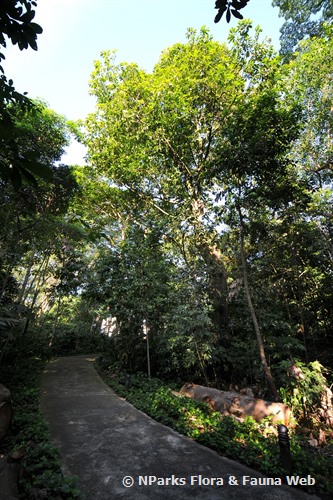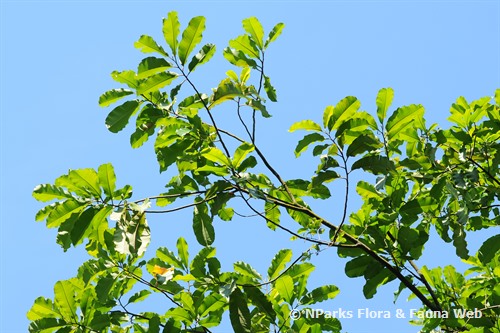
Back
Bertholletia excelsa
| Family Name: | Lecythidaceae |
| Common Name: | Brazil Nut, Brazil-nut Tree, Para Nut |
Name
Classifications and Characteristics
| Plant Division | Angiosperms (Flowering Seed Plants) |
|---|---|
| Plant Growth Form | Tree |
| Maximum Height | 50 m |
Biogeography
| Native Distribution | Brazil |
|---|---|
| Native Habitat | Terrestrial |
| Preferred Climate Zone | Tropical |
| Local Conservation Status | Non-native |
Description and Ethnobotany
| Growth Form | It is a tree, up to 50m tall. Bark are greyish brown and has deep fissures. |
|---|---|
| Foliage | Leaves are leathery, oblong to elliptic (17 – 45 cm long and 6.5 – 15.5 cm wide) in alternate arrangement. Leaves are smooth on both surfaces with prominent veins and wavy margin. Leaf tip is rounded to acuminate while base is rounded. Petiole is 2 – 6 cm long. |
| Flowers | Inflorescence (10 – 20 cm long) occurs at the axillary and terminal position, comprises of 10 – 40 tiny flowers. Each flower is 2 – 3 cm diameter, with 6 oblong creamish yellow petals and 2-lobe calyx. Androecial hood is white to yellow and 80 – 135 stamens are arranged in an asymmetrical ring. Ovary is inferior. |
| Fruit | Fruit is woody, large (8 – 15 cm diameter) and variable shape and size but generally round. Fruit contains about 15 – 25 seeds, and each seed is about 3 -5 cm long with thick bony seed coat. Fruit does not split open when ripe. |
| Associated Fauna | Flowers are pollinated by bees. |
| Cultivation | It is not tolerant to waterlogged soil, and is self-incompatible. |
| Etymology | The genus commemorates a French chemist Claude-Louis Berthollet (1748-1822). The epithet excelsa refers to the great height that the tree can grow to. |
| Ethnobotanical Uses | Edible Plant Parts : Edible Fruits Food (Fruit or Vegetable) |
Landscaping Features
| Desirable Plant Features | Ornamental Flowers |
|---|
Fauna, Pollination and Dispersal
| Pollination Method(s) | Biotic (Fauna) |
|---|
Plant Care and Propagation
| Light Preference | Full Sun |
|---|---|
| Water Preference | Moderate Water |
| Plant Growth Rate | Moderate |
| Rootzone Tolerance | Well-Drained Soils |
Foliar
| Mature Foliage Colour(s) | Green |
|---|
Floral (Angiosperm)
| Flower Colour(s) | Cream / Off-White, Yellow / Golden |
|---|---|
| Flower Grouping | Cluster / Inflorescence |
| Flower Location | Axillary, Terminal |
Fruit, Seed and Spore
| Mature Fruit Colour(s) | Brown |
|---|
Image Repository
Others
| Master ID | 1985 |
|---|---|
| Species ID | 3277 |
| Flora Disclaimer | The information in this website has been compiled from reliable sources, such as reference works on medicinal plants. It is not a substitute for medical advice or treatment and NParks does not purport to provide any medical advice. Readers should always consult his/her physician before using or consuming a plant for medicinal purposes. |

